
|
American Logo
|
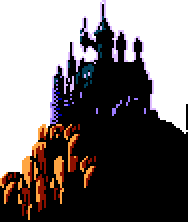 |
Japanese Logo
|
 |
 |
|
|
|
|
| . | . | . | ||
|
General
Information
|
||||
|
|
||||
| Date Released: 2005 |
|
Heroes: Soma Cruz | Secret: Julius Belmont, Yoko Belnades and Alucard | ||
|
|
||||
| Stage Number: 12 Castle Sections |
|
Size: 64MB | ||
|
|
||||
|
Original
System(s)
Nintendo DS |
||||
|
|
||||
|
Ported
To
Cell Phones |
||||
|
............................Alternate
Names/Systems
Akumajou Dracula: Sougetsu no Juujika -- translation: Demon Castle Dracula: Cross of the Blue Moon (Japan) |
||||
|
|
||||
|
Re-release Information (1) 2006: The
DS title is re-released in Japan under the Konami
the Best series |
||||
|
Manual Story Description Castlevania: Dawn of Sorrow's instruction manual does not feature a story introduction--it hits mostly on game mechanics. Though, its final pages list the main characters and provide short biographies, which you can see here. |
||||
|
|
||||
|
Objective/Overview Dawn of Sorrow is the direct storyline follow-up to 2003's Castlevania: Aria of Sorrow, the final of three GBA titles. It's on the DS where the developers, the famed Dracula X team, have finally found what they seek: Hardware powerful enough to at least match the original Playstation, where they exhibited their best work. Predictably so, Dawn of Sorrow is another in the line of RPG-adventures, cut mostly from Aria's mold. You'll again take control of Soma Cruz, within whom the Dark Lord's true power lay dormant, and guide him through the mysterious cult's twelve-section castle, where he'll (a) battle a large assortment of enemy characters, old and new alike, (b) negotiate some twisted obstacles, and (c) battle the obligatory boss creatures. With at the start only his fists and a weak knife, Soma will have to increase his potency via the RPG system, which entails the equipping of more and more powerful armament, the gaining of levels, and the usage of special item types. Too, Soma will again utilize the soul system, which provides him four types of power: Bullet (sub-weapons); Guardian (helpers); Enchanted (body enhancers); and Ability (relic-like powers such as sliding, double jumping and dashing). Depending upon how much attention you pay during the course of this adventure, you'll earn Soma one of three endings. Included is the "Enemy Set Mode," where you can create a short gauntlet challenge using enemies encountered in the main mode; therein, you can use the DS' wireless capability to send this data to your DS-owning friends, who can then take on your enemy-onslaught challenge. As you satisfy certain conditions, you'll unlock newer modes: (1) You can play through the game on a "hard" mode. (2) You can play in "Julius Mode," where you'll in Dracula's Curse-like fashion take control of a Belmont and his allies (Yoko Belnades and Alucard) for an unrelated story mission. (3) The "Boss Rush" mode is back yet again. And (4) you can access the always-favorite sound test. |
||||
|
|
||||
|
Japanese/European Differences All versions of Dawn of Sorrow are identical to each other in mechanics, in palette, in play control, and in extras. A main difference, as usual, is the deviations in the names--this mostly in the case of the enemies. Notable changes: Oujia Table is "Turnate Table." Warg is "Fenrir." Student Witch is "Witch Apprentice." Slaughterer is "Fat Slaughterer." Mollusca is "Monumonu." Cave Troll is "Chupacabra." Yorick is "Soccer Boy." The Creature is "Franken." Corpseweed is "Man-Faced Plant." Tombstone is "Grave." Waiter Skeleton is "Skeleton Boy." Persephone is "Proserpina." Skelerang is "Boomerang Skeleton." Guillotiner is "Guillotine Devil." Malachi is "Evil." Bugbear is "Buckbaird." Bone Ark is "Mobile Bone Pillar." Mushussu is "Mushufushu." Dead Warrior is "Dead Trooper." Slogra is "Berigan." Aguni is "Agni." Celia Fortner is instead "Seria." Soma Cruz is "Kurusu Souma." And, as usual, Julius Belmont's last name is instead "Belmondo." There's another deviation in terms of voice samples, which are more numerous in the Japanese version. For example: When you enter Hammer's shop, he says "welcome" ("Irrashi") along with a few other comments after you buy and sell items ("Is that all?", e.g.). The same goes for bosses. In our version, they simply took out the voice samples that have no suitable English substitutions. (Thanks to Sam Mills for this information.) Again, surprisingly, localization has seen to it that many of the returning enemies now officially take their original Japanese names. For instance: The enemy always known in the western-game versions as Thornweed is now called "Une." You can see the slow homogenization taking place--at least here; on the other side of the coin, the series is once again in Japan known as "Akumajou Dracula," since Japanese gamers apparently didn't take too well to the name-change that saw it become "Castlevania" universally. Also, as it was in Aria of Sorrow, Kurusu Souma is again referenced as a Japanese man rather than an "exchange student," which was done in localization for the purposes of better acclimating the character to western audiences. Of lesser importance is that you can't skip past cut-scenes, which you can do in the other versions by hitting "Start." |
||||
|
Soundtrack and Credits Soundtrack Links |
||||
|
|
||||
|
Other Characters Lesser Enemies:
Zombie, Bat, Ghost, Skeleton, Ouija Table, Peeping Eye, Axe Armor, Skull
Archer, Warg, Spin Devil, Armor Knight, Student Witch, Slaughterer,
Bomber Armor, Golem, Slime, Une, Skeleton Ape, Manticore, Mollusca,
Rycuda, Mandragora, Yorick, Skeleton Farmer, The Creature, Catoblepas,
Ghoul, Corpseweed, Yeti, Tombstone, Ghost Dancer, Flying Humanoid, Mini
Devil, Quetzalcoatl, Treant, Amalaric Sniper, Valkyrie, Great Armor,
Killer Doll, Waiter Skeleton, Persephone, Witch, Buer, Lilith, Killer
Clown, Skelerang, Fleaman, Devil, Guillotiner, Draghignazzo, Needles,
Hell Boar, Bone Pillar, White Dragon, Wakwak Tree, Imp, Harpy, Barbariccia,
Malachi, Cave Troll, Larva, Heart Eater, Merman, Fish Head, Medusa Head,
Ukoback, Killer Fish, Mimic, Dead Pirate, Frozen Shade, Homunculus,
Disc Armor, Decarabia, Dead Mate, Bugbear, Procel, Bone Ark, Gorgon,
Alura Une, Great Axe Armor, Moth Man, Mushussu, Dead Crusader, Dead
Warrior, Erinys, Succubus, Ripper, Black Panther, Mud Demon, Giant Slug,
Werewolf, Flame Demon, Tanjelly, Arc Demon, Gaibon, Slogra, Stolas,
Final Guard, Malacoda, Alastor and Iron Golem |
||||
|
|
||||
|
Character Lists |
||||
| . | . | . | ||
![]()
|
Hero
Image
|
Statistics
|
|
|
|
Full Name: Soma Cruz | |
| Main Weapon: Fists and a Knife | ||
| Weapon Power-Up: Click here for Soma's comprehensive list | ||
| Alternate Weapons: Click here for Soma's comprehensive list | ||
| Sub-Weapon Power-Up: Click here to see Soma's bullet souls | ||
| Special Abilities: Can double jump; jump kick; slide; back dash; super jump; uppercut (with no weapon equipped); and add a special power to each hand weapon. He can also transform/gain powers via his collected souls | ||
| Armor: Click here for Soma's comprehensive list | ||
 Limitations:
Soma
is your standard adventure-RPG hero: He
moves quickly and he jumps gracefully, able to control each jump till
its very end. His
starting weapon is a short knife, and he has immediate slide- and jump-kick
abilities, which should allow him to survive in the early going. However,
Soma will need increased ability to fully navigate the castle and deal
with its tougher foes; he'll do this by collecting more convenient weaponry
and by using his absorbing power to collect Ability Souls, which supply
him the all-encompassing accessibility moves like the double jump, slide
and later the not-as-useful super jump. Soma will also have to gain experience,
naturally, in order to gain levels, which will up his stats accordingly.
The
three other category of soul powers aid this process by supplying to him
multiple sub-weapons, guardian helpers, transformation propensity, and
different enhancers. Really--it's up to you to decide how powerful Soma
becomes. Limitations:
Soma
is your standard adventure-RPG hero: He
moves quickly and he jumps gracefully, able to control each jump till
its very end. His
starting weapon is a short knife, and he has immediate slide- and jump-kick
abilities, which should allow him to survive in the early going. However,
Soma will need increased ability to fully navigate the castle and deal
with its tougher foes; he'll do this by collecting more convenient weaponry
and by using his absorbing power to collect Ability Souls, which supply
him the all-encompassing accessibility moves like the double jump, slide
and later the not-as-useful super jump. Soma will also have to gain experience,
naturally, in order to gain levels, which will up his stats accordingly.
The
three other category of soul powers aid this process by supplying to him
multiple sub-weapons, guardian helpers, transformation propensity, and
different enhancers. Really--it's up to you to decide how powerful Soma
becomes. |
|
Hero
Image
|
Statistics
|
|
|
|
Full Name: Julius Belmont | |
| Main Weapon: Vampire Killer Whip | ||
| Weapon Power-Up: None | ||
| Alternate Weapons: None | ||
| Sub-Weapon Power-Up: None | ||
| Special Abilities: Can double jump, back-dash, slide, jump kick, brandish the whip, and throw a midair uppercut (which can act as a third jump) | ||
| Armor: None | ||
| Limitations: Julius is one of three characters you can control in "Julius Mode," which has its own rules but is certainly reminiscent of the usual secret-character missions. Julius can go anywhere almost without restriction, and his is of course the more traditional arsenal: (1) He utilizes the Vampire Killer whip, which he can swing left and right and thus brandish; for a typical whip-swing, he can score two hits at one time. And (2) Julius can switch between four available sub-weapons--an axe, holy water, a boomerang and a special cross--that are powered by the magic meter. He also has the standard special moves (back dash, slide, double jump and jump kick), with the midair uppercut--an attack and a third jump--as a new addition. In comparison to the two other secret characters, Julius is medium strength but the best long-range fighter thanks to the lengthy whip and more secondary options (the magic-draining sub-weapons). It should be noted that Julius and his allies share an unseen status-tracker, which allows the trio to gain levels through repeated combat. |
|
Hero
Image
|
Statistics
|
|
|
|
Full Name: Yoko Belnades | |
| Main Weapons: Magic Staff and High Kick (while crouching) | ||
| Weapon Power-Up: None | ||
| Alternate Weapons: None | ||
| Sub-Weapon Power-Up: None | ||
| Special Abilities: Can double jump, slide, and back-dash with a flip | ||
| Armor: None | ||
| Limitations: Yoko is the first ally to be met in "Julius Mode." While Yoko is clearly lacking in the area of special moves, she makes up for it in spades thanks to her superior magical ability. He staff and her crouching kick are very weak offensive options, yes, but they both share an important quirk: Each time she strikes an enemy, she'll sap some of its energy (depending on the group level) and use it to replenish her own. This is very useful during boss battles because the group has no means for normal energy replenishment. Otherwise, Yoko commands the three magical spells once utilized by her ancestor Sypha; the three spells--fire, ice and lightning, between which she can cycle--are so powerful that she can overwhelm minor enemies and most bosses alike. Compared to the other secret characters, Yoko is physically the weakest and least durable, but by her very on-screen presence, the group's magic meter will replenish more rapidly. |
|
Hero
Image
|
Statistics
|
|
|
|
Full Name: Alucard (real name: Adrian Farenheights Tepes) | |
| Main Weapon: Alucard Sword | ||
| Weapon Power-Up: None | ||
| Alternate Weapons: None | ||
| Sub-Weapon Power-Up: None | ||
| Special Abilities: Can double jump, super jump, back-dash, jump kick, turn into a bat, release three-directional fireballs, and use the Alucard Sword for a special quick transport-and-return attack (as in Symphony) | ||
| Armor: None | ||
| Limitations: The half-breed son of Count Dracula will join the group as its last member. As his appearance suggests, Alucard has been ripped directly from Symphony of the Night, though his abilities are this time controlled. Available to him are all of the special moves you'll remember from Symphony, but he's confined, equipment-wise, to only his quick-hitting Alucard Sword (which again has a magic-draining special attribute). Otherwise, he has at his command two sort-of sub-weapons that you'll also recognize: You can switch between the Soul of Bat, which allows him to transform into a pesky bat, and Hellfire, the spell that allows him to spew three-directional fireballs. Each drains the magic meter in a specific way. Compared to the other secret characters, Alucard is the strongest, the quickest--both in movement and on the draw--and the most durable. Even so, his overall usefulness isn't that much greater. |
|
Weapon
Name
|
Weapon
Image
|
Description
|
|
Fists
|
|
Without
a weapon equipped, Soma will rely on short jabs
|
|
Knife
|
|
Soma
begins the game with a short knife used for quick stabs
|
|
Vampire
Killer
|
|
Ancient
steel-enhanced whip of the Belmont clan
|
|
Alucard Sword
|
|
His mother's family
heirloom; Alucard uses it for quick sword-swipes
|
|
High Kick
|
|
From a crouching
position, Yoko throws upward high kicks
|
|
Magic Staff
|
|
Short,
weak magical staff used for quick downward slashes
|
![]()
|
Magical
Items
|
|||
|
Item Name
|
Image
|
Found In
|
Usage
|
|
Heart
|
|
Candle, Structure
|
Restores Magic
Power
|
|
Big Heart
|
|
Structure
|
Restores Magic
Power
|
|
Coin
|
|
Candle, Enemy, Structure
|
Currency
|
|
Money Bag
|
|
Laying Around
|
Currency
|
|
Crystal
|
|
Boss Creature
|
Clears Room/Restores
Stats
|
![]()
|
Sub-Weapons
|
|||
|
Weapon
Name
|
Image
|
Magic Consumption
|
Comments
|
|
Holy Water
|
|
4MP
|
Julius Only
|
|
Boomerang
|
|
5MP
|
Julius Only
|
|
Axe
|
|
5MP
|
Julius Only
|
|
Cross
|
|
17MP
|
Julius Only
|
|
Holy Flame
|
|
4MP
|
Yoko Only
|
|
Ice
|
|
5MP
|
Yoko Only
|
|
Lightning
|
|
17MP
|
Yoko Only
|
|
Soul of Bat
|
|
1MP Per Half-Second
|
Alucard Only
|
|
Hellfire
|
|
6MP
|
Alucard Only
|
![]()
Screenshots/Media
Local Title Screens
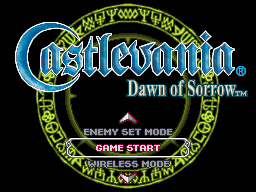 |
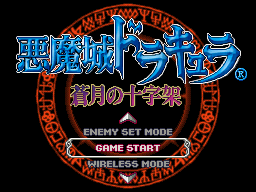 |
|
U.S.
Title Screen
|
.
|
Japanese Title
Screen
|
Action Shots


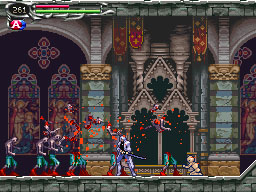
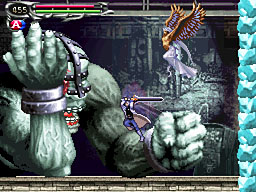
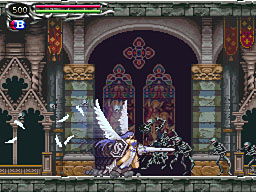
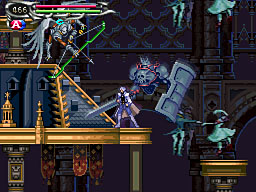


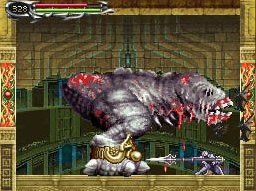
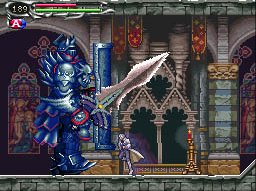

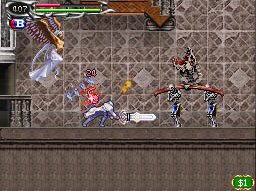
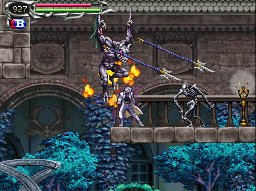


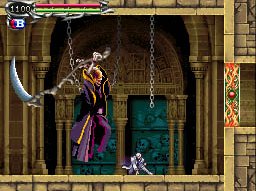
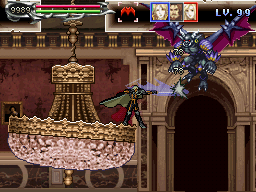

|
Quick-Reference
Links
|
||
|
Category
|
Availability
|
What's
Inside
|
|
Stages:
|
Dawn of
Sorrow's twelve stage areas dissected and explained
|
|
|
Review:
|
The first
DS entry: The series reinvented or more of the same?
|
|
|
Codes:
|
"Julius
Mode" in detail | Fun with Souls | Hidden Treasures
|
|
|
Magazine
Coverage
|
|
|
Item Name
|
Description
|
|
Shown are the front
and back magazine covers plus select page samples
|
|
|
The official U.S.
guide provides the usual coverage plus an IGA interview
|
|
Text Documents
and Help Files
|
||
|
Walkthroughs
|
FAQs
|
Other Files
|
|
-
|
-
|
|
|
-
|
-
|
|
|
-
|
-
|
|
|
Scenes,
Packaging Scans and More
|
||
|
American
Version
|
Japanese
Version
|
European
Version
|
|
-
|
||
|
-
|
-
|
|
|
-
|
-
|
|
|
-
|
-
|
|
|
-
|
-
|
|
|
[Home] [What's New?] [CV Library] [Stages] [Reviews] [Weapons] [Castleography] [Multimedia] [Codes] [Links] |
||||